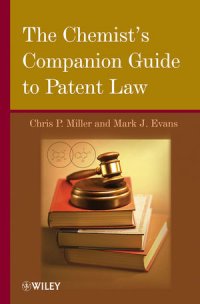
Ebook: The Chemist’s Companion Guide to Patent Law
Author: Chris P. Miller Mark J. Evans
- Year: 2010
- Edition: 1st
- Language: English
- pdf
Written by an individual with experience as both a chemist and a patent attorney, The Chemist's Companion Guide to Patent Law covers everything the student or working chemist needs to know about patentability, explaining important concepts of patent law (such as novelty, non-obviousness, and freedom-to-operate) in easy-to-understand terms. Through abundant examples from case law as well as real-world situations with which a researcher might be faced, this book provides readers with a better understanding of how to put that knowledge into practice.Content:
Chapter 1 Patent Basics (pages 1–18):
Chapter 2 The Patent Process (pages 19–79):
Chapter 3 Prior Art and the Chemical Invention (pages 80–116):
Chapter 4 Inventorship (pages 117–133):
Chapter 5 Patent Claims (pages 134–155):
Chapter 6 Basic Requirements of Patentability: Utility (pages 156–167):
Chapter 7 Basic Requirements of Patentability: Novelty (pages 168–197):
Chapter 8 Basic Requirements of Patentability: Nonobviousness (pages 198–280):
Chapter 9 Basic Requirements of Patentability: Written Description, Enablement, and Best Mode (pages 281–317):
Chapter 1 Patent Basics (pages 1–18):
Chapter 2 The Patent Process (pages 19–79):
Chapter 3 Prior Art and the Chemical Invention (pages 80–116):
Chapter 4 Inventorship (pages 117–133):
Chapter 5 Patent Claims (pages 134–155):
Chapter 6 Basic Requirements of Patentability: Utility (pages 156–167):
Chapter 7 Basic Requirements of Patentability: Novelty (pages 168–197):
Chapter 8 Basic Requirements of Patentability: Nonobviousness (pages 198–280):
Chapter 9 Basic Requirements of Patentability: Written Description, Enablement, and Best Mode (pages 281–317):
Download the book The Chemist’s Companion Guide to Patent Law for free or read online
Continue reading on any device:

Last viewed books
Related books
{related-news}
Comments (0)